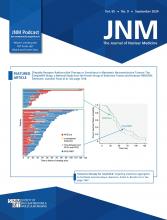REPLY: We thank the authors of the letter to the editor for their thoughtful comments on our article, “The Diagnostic Value of the Sentinel Node Procedure to Detect Occult Lymph Node Metastases in PSMA PET/CT Node–Negative Prostate Cancer Patients” (1). We appreciate the opportunity to clarify several key points.
First, translating the sentinel lymph node (SLN) procedure into routine clinical prostate cancer practice is challenging. SLN procedures require preoperative planning and collaboration with specialized nuclear medicine facilities. Although emerging evidence shows positive short to intermediate outcomes, long-term randomized controlled trial data are lacking.
Second, we agree that interpreting negative prostate-specific membrane antigen (PSMA) PET/CT findings is complicated by different scanning protocols and PSMA-targeting tracers. Both Klingenberg et al. (2) and Jilg et al. (3) showed that most lymph node metastases not detected on PSMA PET/CT had PSMA expression on immunohistochemistry, and the detection rate increased with larger lymph node metastases. These findings suggest that lymph node metastases on PSMA PET/CT rarely lack PSMA expression but are often missed because of low tumor volume.
Third, performing SLN biopsies in patients with negative PSMA PET/CT scans is supported by previous research (4) demonstrating that adding SLN biopsy to PSMA PET/CT for primary lymph node staging in intermediate- and high-risk prostate cancer patients yields 100% sensitivity. In higher-risk populations, the negative predictive value of PSMA PET/CT decreases while the positive predictive value increases (5). Therefore, minimizing the risk of missing lymph node metastases in high-risk populations justifies SLN biopsies even in patients with negative PSMA PET/CT scans. Moreover, macrometastases detected by PSMA PET/CT may result in false-negative SLN detection due to lymph blockage, making SLNs less reliable.
Fourth, regarding treatment escalation in node-positive patients, large retrospective studies show improved survival after whole-pelvis radiotherapy in clinically or pathologically node-positive patients (6). Recently, the randomized POP-RT trial showed that prophylactic whole-pelvis radiotherapy was associated with improved survival in high-risk patients (7). We hypothesize that a substantial subset of patients had undetected PSMA PET/CT nodal metastases, benefiting from nodal treatment intensification. Nevertheless, long-term randomized data supporting treatment escalation based on nodal status are needed.
Finally, SLNs in challenging locations were left in situ if multiple nodes were present on preoperative SPECT, as removing these nodes might increase surgical complications. Of 31 patients with SLNs left in situ, 10 were pN1 (32%) and 21 were pN0 (68%). Studying radiologic recurrence patterns in these patients could indicate false-negative cases due to unresected SLNs. As many of these patients are still receiving androgen-deprivation therapy, it is too early to report on these results.
We share your enthusiasm for SLN mapping in prostate cancer staging and appreciate your efforts to highlight important considerations. Building on retrospective evidence for SLN-directed radiotherapy, the ENTAIL trial, a randomized control trial to evaluate the oncologic value of SLN-based radiotherapy field tailoring, is currently awaiting approval from the Medical Ethics Committee of The Netherlands Cancer Institute.
DISCLOSURE
No potential conflict of interest relevant to this article was reported.
Jan J. Duin, Hilda A. de Barros*, Pim J. van Leeuwen, Henk G. van der Poel
Netherlands Cancer Institute–Antoni van Leeuwenhoek Hospital, Amsterdam, The Netherlands
*E-mail: h.d.barros{at}nki.nl.
Footnotes
Published online Jul. 25, 2024.
- © 2024 by the Society of Nuclear Medicine and Molecular Imaging.
REFERENCES
- Received for publication June 10, 2024.
- Accepted for publication June 21, 2024.







